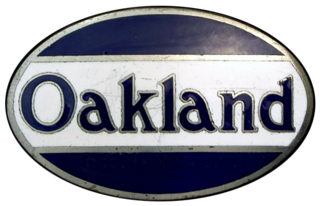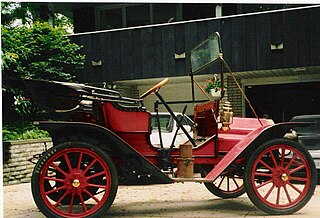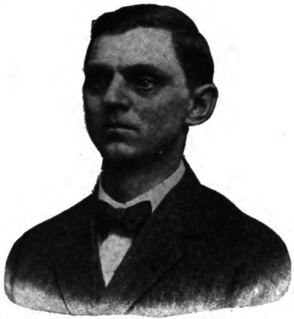
Charles Williams Nash was an American automobile entrepreneur who served as an executive in the automotive industry. He played a major role in building up General Motors as its 5th President. In 1916, he bought Thomas B. Jeffery Company, makers of the popular Rambler automobile, renamed it Nash Motors, and played an independent role in an automobile industry increasingly dominated by the Big Three: General Motors, Ford, and Chrysler. His profits came from focusing on one well-designed car in the upper-medium price range. He bought several distressed companies in Wisconsin, merging them and installing advanced managerial accounting procedures while cutting costs and focusing on long-term growth. He retired as president in 1932, but remained chairman of the board. His major acquisition was the merger in 1937 with the Kelvinator Company, which made refrigerators. During World War II, Nash-Kelvinator greatly expanded to manufacture aircraft engines and parts.

William Crapo Durant was a leading pioneer of the United States automobile industry and co-founder of General Motors and Chevrolet. He created a system in which a company held multiple marques – each seemingly independent, with different automobile lines – bound under a unified corporate holding company. Durant, along with Frederic L. Smith, co-founded General Motors, as well as Chevrolet with Louis Chevrolet. He also founded Frigidaire.

The General MotorsJ platform, or J-body, is an automobile platform that was used by General Motors for compact cars from the 1982 to 2005 model years. The third generation of compact cars designed by GM, the J-body marked the introduction of front-wheel drive for its compact model lines, replacing the rear-wheel drive H platform. The J-body was marketed as a world car, with GM brands selling versions of the platform in North America, Europe, Australia, and Japan; in markets outside of North America, the model line was packaged as a mid-size car.

The Pontiac Astre is a subcompact automobile that was marketed by Pontiac as a rebadged variant of the Chevrolet Vega. Initially marketed in Canada for model years 1973–1974, the Astre debuted in the U.S. for the 1975 model year, competing with other domestic and foreign subcompacts that included the Mercury Bobcat, Volkswagen Rabbit, and Toyota Corolla.

The Oldsmobile Series 70 is a full-size midrange automobile produced by Oldsmobile between the 1939 and 1950 model years. Oldsmobiles of this time period were in an unusual "middle" position in GM's hierarchy of automobile brands. Chevrolet and Pontiac were the budget priced models, while Buick and Cadillac were the luxury brands. GM would share their "A" body platforms between Chevrolet, Pontiac, and "B" body on Oldsmobile and Buick, while leaving Cadillac on the senior "C" platform. Oldsmobiles were then branded as "luxury level" Chevrolet's and Pontiac's, while Oldsmobiles using the "B" platform were "budget priced" Buicks and Cadillacs.

Viking was a brand of automobiles manufactured by General Motors as a supplement to Oldsmobile division for model years 1929 to 1931 and used the GM B platform. It was shared with the Oakland Model 301 for 1930 and 1931.

The Oakland Motor Car Company of Pontiac, Michigan, was an American automobile manufacturer and division of General Motors. Purchased by General Motors in 1909, the company continued to produce modestly priced automobiles until 1931 when the brand was dropped in favor of the division's Pontiac make.

Elmore Manufacturing Company was a manufacturer of veteran and brass era automobiles and bicycles (1893–97), headquartered at 504 Amanda Street, Clyde, Ohio, from 1893 until 1912. The company took its name from a small parcel of land in Clyde with the name Elmore associated with it where a stave mill was established originally, then evolved into bicycle production. The village of Elmore, Ohio is located 20 mi (32.2 km) to the east. Founded by Harmon Von Vechten Becker and his two sons, James and Burton, the Elmore used a two-stroke engine design, in straight twin or single-cylinder versions. They later produced a straight-3 followed by a straight-4 beginning in 1906 until production ended in 1912. The company advertising slogan was "The Car That Has No Valves", referring to the two-stroke engine.

E. R. Thomas Motor Company was a manufacturer of motorized bicycles, motorized tricycles, motorcycles, and automobiles in Buffalo, New York between 1900 and 1919.

The Thomas B. Jeffery Company was an American automobile manufacturer in Kenosha, Wisconsin, from 1902 until 1916. The company manufactured the Rambler and Jeffery brand motorcars. It was preceded by the Gormully & Jeffery Manufacturing Company, a bicycle manufacturer. It was the parent company to Nash Motors, thus one of the parent companies of American Motors Corporation (AMC) and later Chrysler.

In the late 1920s, American automotive company General Motors (GM) launched four companion makes to supplement its existing lineup of five-passenger car brands, or makes. The companion makes were LaSalle, introduced for the 1927 model year to supplement Cadillac; Marquette, introduced in 1929 for 1930 to supplement Buick; Pontiac, introduced for 1926 to supplement Oakland; and Viking, introduced for 1929 to supplement Oldsmobile. GM's fifth existing brand, Chevrolet, did not receive a companion make. With the exception of Viking, each of the companion makes were slotted below their "parent make" in GM's pricing hierarchy.

Marquette was an American automobile manufacturer established by General Motors in 1909 after the purchase of the Rainier Motor Car Company. The Marquette Company did not last long and in 1912 GM announced the company would be closed.

The Chevrolet Superior Series F was launched in 1923, manufactured by Chevrolet for four years with a different series per year. The 1923 model was known as the Series B, the 1924 model was the Series F, for 1925 it was known as the Series K and the 1926 Superior was known as the Series V. It was replaced in 1927 by the Series AA Capitol. It was the first Chevrolet that didn't have a larger companion model and was the only car sold by Chevrolet in several body style configurations all supplied by Fisher Body. Each year new mechanical changes, appearance updates or optional features that became standard in subsequent years became expected of all GM products including Chevrolet. Body styles were separated into open and closed which meant closed included retractable glass in the doors and glass surrounding rear seat passengers. Standard items included tools, a jack for tire removal, speedometer, outside lockable door handles, ammeter, oil pressure gauge, dashboard light, choke pull knob, electric horn, ignition theft lock, and a two piece vertical ventilating windshield that allowed fresh air to enter the passenger compartment. Wheels were 30" and came standard with hickory wood spokes or optional pressed steel discs. For 1925, bumpers were offered optionally along with outside side view mirrors, heater for passenger compartment and a clock.

The Buick Model B was Buick's first model as an independent company, later becoming part of General Motors in 1908. It was built in Jackson, Michigan. A model B was exhibited in 1905 at the New York Auto Show as a promotion of the model C which would be the same. William C. Durant introduced the car himself at the exhibit, and took new car orders at the car show, raising sales from 37 cars in 1904 to 750 in 1905. It had a 2-cylinder, horizontally opposed engine – the world's first production OHV engine – installed lengthwise within the frame, had a planetary transmission, with a cone clutch and two forward speeds and one reverse gear. The engine was rated at 21 bhp. In later years, it was renamed as improvements were made. The chassis was shared later with the Oldsmobile Model 20 when they became a division of GM while the overhead valve engine wasn't used by Oldsmobile. It had a retail price of US$950 for the touring sedan.

The Chevrolet Series C Classic Six is the first automobile produced by American car manufacturer Chevrolet. It is one of the few Chevrolets made while record-setting Buick race car driver Louis Chevrolet was with the company. This Brass Era Chevy was much larger, more powerful, more stylized and therefore more expensive than the cars that would ultimately replace it. Louis Chevrolet loved it, but William Durant had a cheaper car in mind.

The Chevrolet Series 490 is an early American automobile, made from 1915 to 1922 by Chevrolet. Introduced in June 1915, the 490 sold for $490. Chevrolet 490 was an immediate success and established the brand as a big player. The name would not denote the price for long, but it would stay low enough to take a chunk out of the Model T market. The Model T started at $495 at the time. Chevrolet was soon so profitable that Chevrolet owner Billy Durant began buying shares of GM stock with his Chevrolet stock, enough that he was able to take control of GM and merge Chevrolet with it. Electric horns were standard. And by 1921, standard equipment included a speedometer, and ammeter, dome lights, and headlight dimmers.

Byron J. Carter, was an American automotive pioneer. He was a founding partner of the Jackson Automobile Company, and founder of the Cartercar Company.

The Chevrolet Series F of 1917 was an American automobile manufactured by Chevrolet before they became a division of General Motors. The successor of the Series H, it had a longer wheelbase and other improvements, but kept the same engine. It was replaced the following year by the Series FA in 1918, which had a larger, more powerful engine. It was sold as the larger alternative to the Chevrolet Series 490, and the Model F was available for US$800 as either a roadster or touring sedan. As the Model F and Series 490 were in direct competition with the Ford Model T, sales were recorded at 110,839 for Chevrolet, with 57,692 Series 490 and 3,493 Model F. Chevrolet instituted Knock-down kit assembly where the product was created at Flint Assembly, then shipped by rail to the branch locations and locally assembled using locally sourced items such as tires, glass and other items. In 1917, the Monroe Motor Company was sold to William Small of Flint MI and was no longer sold by independent Chevrolet dealers when they weren't part of GM. Mason Motor Company was merged into Chevrolet once it became a division of GM and was used to supply engines for GM-Chevrolet vehicles.
The Welch Motor Company was an American automobile company headquartered in Chelsea, Michigan. It started in 1901 and continued production of luxury vehicles until 1911 when it merged with General Motors.
The Model 42 was an entry-level four seat passenger car produced by GM's Oldsmobile Division in 1914, offered as a replacement to the Oldsmobile Curved Dash runabout when it was discontinued in 1908, and was the junior platform to the Oldsmobile Six introduced in 1913. GM had acquired Elmore Manufacturing Company, Oldsmobile and Oakland Motor Car Company in 1908 and Cartercar and Rainier Motor Car Company in 1909 as their entry-level models, and Oldsmobile products were being repositioned in their new hierarchy as GM began to consolidate operations after William Durant had left.


























